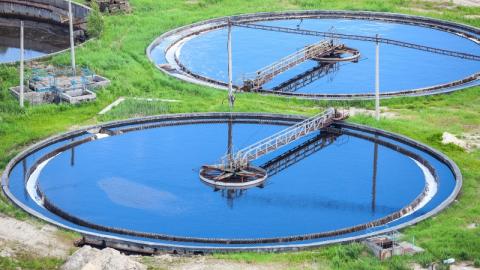The Languedoc Roussillon region itself must face a major challenge: ensuring there are enough water resources to cope with tourism and droughts while preserving the countryside. The Aqua Domitia project aims to address this challenge.

Aqua Domitia: a unifying project, of which the first phase was completed in 2016.
The highly attractive Languedoc Roussillon region is experiencing strong demographic growth. Over the past 30 years, temperatures have risen by an average of 1°5, and the region has experienced recurrent droughts, during which water resources have become scarce.
A unifying project was adopted by the region and by the departments of Hérault and Aude. Known as Aqua Domitia, the project allows for the networks supplied by water from the Rhône to be regulated.
It consists of an extension of the large multi-purpose untreated water supply network, created by BRL in the 1960s to support the transformation of agriculture and the urban and tourist development of the Gard, Hérault and Aude regions, by mobilising renewable resources from the Rhône or from dams.
The project seeks to secure the water resources for the territories from Montpellier to the coast to be able cope with the shortages resulting from the drought and tourism.
Aqua Domitia consists of a network of untreated water pipes laid over around 130 km, the diameter of the pipelines being 60 to 120 cm. It is planned that the project will be implemented progressively, section by section, in strict collaboration with all players of the territories in question and considering the urgency of the needs to be met locally.
The total cost is 140 million euros. This is a project that relates to the need to face up to the increased water requirements resulting from the influx of new populations and not to waste drinking water.
By combining the water resource provided by the Rhône with local resources, the project fulfils the needs of the economic and tourist sectors; this represents an important economic growth factor and competitiveness for the territories and makes it possible to reduce the withdrawals from the most used aquatic environments.
Aqua Domitia, therefore, constitutes a second resource for the territories and security for future generations.
The first phase of the project was achieved in 2016. The Occitania / Pyrenees -Mediterranean Region is the main funder of the program. Co-financing is also provided by BRL as well as by other partners, depending on the territorial issues of each body: Department of Aude, Rhône-Mediterranean-Corsica Water Agency, Department of Hérault, large metropolises such as Béziers Méditerranée, Montpellier Méditerranée Métropole, Sète Agglopôle, Hérault Méditerranée, Syndicat du Bas Languedoc, municipal communities…
More than 6,000 hectares of agricultural land will be linked up within two years.
To face up to the recurring droughts experienced in the South of France over the last few years and the difficulties encountered by the farmers, the timing of the Aqua Domitia project is crucial. So, there will be security for the applications of water to be made by the winegrowers and farmers, particularly during the summer months. These players bear the brunt of the droughts, with the groundwater reserves being barely replenished, the water levels in the rivers already low coupled with the restrictive measures introduced by the local authorities.
They also have to contend with the pressures of tourism, which increases consumption. Within the context of the crisis, the Aqua Domitia network has offshoots to supply the farms and vineyards. “Eight hundred hectares of vines will be supplied in 2024 in Vendres, near Béziers. This will avoid having to make withdrawals from the groundwater reserves in Astien, which must be preserved as it is the only source of drinking water”, explained Jean-François Blanchet, director-general de BRL. One thousand hectares of vines to the north-east of Béziers are now receiving water from the Rhône this year. In total, in 2024, more than 6,000 hectares will be supplied via the resources from the Rhône, through the creation of secondary hydro-agricultural networks.
For its part, the department of Hérault is looking into the creation of a 950,000 m3 winter storage reservoir in Florensac, aimed at supplying 700 hectares of vineyards, within the Picpoul-de-Pinet wine-growing region. Over and above the infrastructural deployment, the innovations are being trialled. A localised replenishment of the groundwater during winter is in progress at the Château de Mus vineyard, in Murviel-les-Béziers.
“A drip irrigation system is replenishing the water in the soil during winter to avoid having to use the water in the summer, the period of peak consumption”, explained Jean-François Blanchet.
Another innovation: to lower the level of salinity accumulated in the soils in Camargue Gardoise, tests are currently being conducted involving the sprinkler irrigation of the vines, in collaboration with INRAE Montpellier. The objective is “to delay the massive salt accumulation in the soil by injecting water into the subsoil. Up to now, there have been sufficient winter rains in Camargue to protect the vines from the phenomenon of excessive salt accumulation in the soil. Now, that is no longer the case.”
Jean-François Blanchet, director general of BRL, advocated the deployment, at national level, of Regional Development companies of the BRL type, a Development Company for the slopes of Gascogne (Compagnie d’aménagement des côteaux de Gascogne) or the Canal de Provence company (Société du Canal de Provence). “These structures were created sixty of seventy years ago, to adapt the territories of the south to the dry Mediterranean context, with an integrated water cycle approach. In 2022, the whole of France suffered from water stress. So would it not be beneficial to expand these development companies elsewhere than in the regions of the South, Occitanie and Aquitaine”, asked the expert.
However, bearing in mind the extent of the droughts of recent years, the depleted groundwater reserves and the drop in the levels of the major rivers, it is reasonable to ask whether these measures will be sufficient in the long term.

